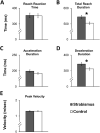Reach Kinematics During Binocular Viewing in 7- to 12-Year-Old Children With Strabismus
- PMID: 34935884
- PMCID: PMC8711010
- DOI: 10.1167/iovs.62.15.21
Reach Kinematics During Binocular Viewing in 7- to 12-Year-Old Children With Strabismus
Abstract
Purpose: Eye-hand coordination is essential for normal development and learning. Discordant binocular experience from childhood strabismus results in sensory and ocular motor impairments that can affect eye-hand coordination. We assessed reach kinematics during visually guided reaching in children treated for strabismus compared with controls.
Methods: Thirty-six children aged 7 to 12 years diagnosed with esotropia, a form of strabismus, and a group of 35 age-similar control children were enrolled. Reach movements during visually guided reaching were recorded using the LEAP Motion Controller. While viewing binocularly, children reached out and touched a small dot that appeared randomly in one of four locations (±5° or ±10°). Kinematic measures were reach reaction time, total reach duration, peak velocity, acceleration duration, and deceleration duration. Touch accuracy and factors associated with impaired reach kinematics were evaluated.
Results: Strabismic children had longer total reach duration (545 ± 60 ms vs. 504 ± 43 ms; P = 0.002), had longer deceleration duration (343 ± 54 ms vs. 312 ± 45 ms; P = 0.010), and were less accurate (93% ± 6% vs. 96% ± 5%, P = 0.007) than controls. No differences were found for reach reaction time, peak velocity, or acceleration duration (all Ps ≥ 0.197). Binocular dysfunction was more related to slow reaching than amblyopic eye visual acuity.
Conclusions: Strabismus affects visually guided reaching in children, with slower reaching in the final approach and reduced endpoint accuracy. Binocular dysfunction was predictive of slow reaching. Unlike strabismic adults who show longer acceleration duration, longer deceleration in the final approach in strabismic children indicates a difference in control that could be due to reduced ability to use visual feedback.
Conflict of interest statement
Disclosure:
Figures




References
Publication types
MeSH terms
Grants and funding
LinkOut - more resources
Full Text Sources

